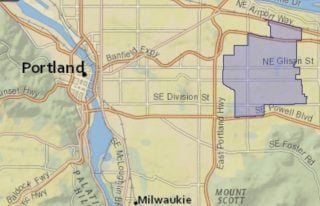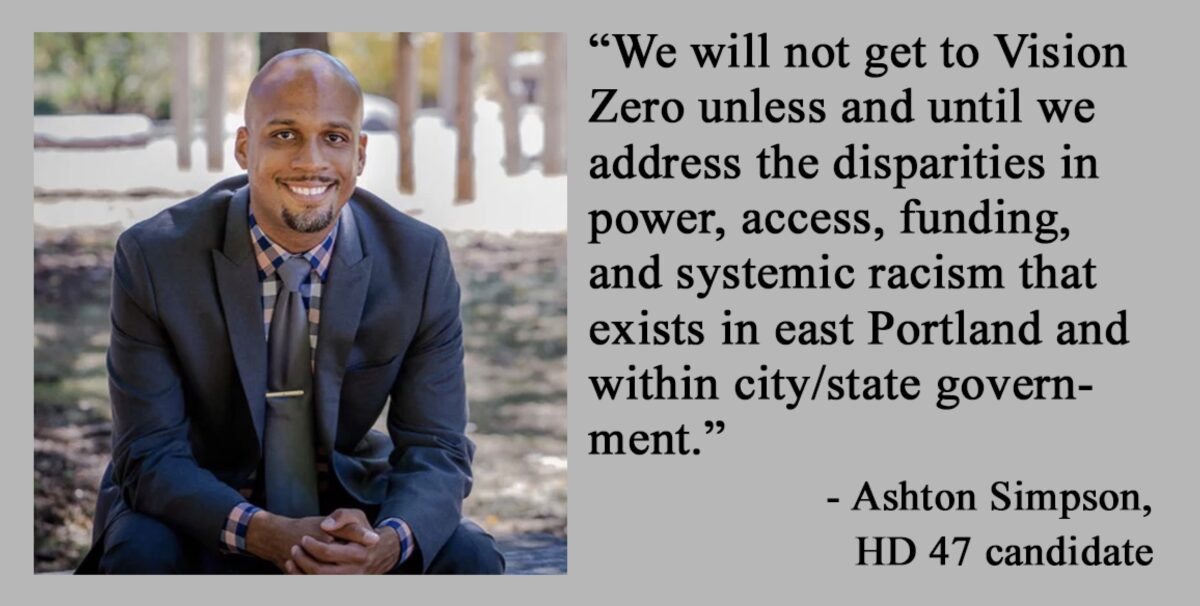With so much attention on the mayoral race and national politics, you might not have heard much about an interesting contest shaping up for a seat in the Oregon House that represents a key swath of east Portland.

When I heard the name Ashton Simpson pop up as a third-party challenger to scandal-plagued incumbent Diego Hernandez, I knew you’d be interested to learn about him. Simpson, who’s running on the Working Families Party ticket, has deep ties to local transportation issues.
As you might have noticed with our recent coverage of new neighborhood greenways, east Portland is seeing a lot of transportation investment at the moment. That stream of funding will become a flood if the Metro transportation measure passes in November. After years of neglect, parts of our city east of I-205 are finally being noticed by City Hall. And it’s active, young leaders like Simpson who are making that happen.
I asked him a few questions via email last week and I’ve shared his responses below. (Edited slightly for clarity.)
How do you get around the city in a normal week?
I live in east Portland where the street design and lack of safe infrastructure limits the choices I have available to me, therefore my primary mode is a car. However, prior to COVID-19 I would use transit whenever heading downtown. I do have a bike and would love to use it more which is one of the reasons I love the work I do advocating for equitable mobility options and investments in East Portland.
What neighborhood do you live in?
I live in the Russell neighborhood. It is one of the few in East Portland that has decent sidewalks until you get to the main streets. I believe in a future where all of East Portland has the same level of investments as the rest of the city.
What transportation projects/issues are you currently involved in?
I’ve had the privilege to be heavily involved in transportation justice work in Portland. My work at The Rosewood Initiative has allowed me to be directly involved in local transportation advocacy over the past few years. I am on the City of Portland’s Pricing Options for Equitable Mobility Task Force, the Rose Lane Project Committee, and am the co-chair of the Fixing Our Streets Oversight body. I was also on the Multnomah County Local Investment Team for the Metro Transportation measure where I advocated for safer streets for all users. I have also worked with PBOT on specific projects, such as reorganizing SE 162nd Ave.
Advertisement
How do you feel about the I-5 Rose Quarter project?
“The hundreds of millions of dollars dedicated to the I-5 project could instead be used to improve underserved parts of the city.”
I believe the I-5 project is a waste of money that will not achieve any of the stated goals. In East Portland, we have major streets like Holgate that still do not have sidewalks. A lot of the neighborhood collectors still look like rural two lane roads, leaving people walking and biking with virtually no space to exist. Justice too long delayed is justice denied. East Portland has been denied adequate investments in biking, walking, and transit despite being annexed half a century ago.
The hundreds of millions of dollars dedicated to the I-5 project could instead be used to improve underserved parts of the city like 82nd Ave., Cully, and East Portland. These funds could increase walking, biking, and transit infrastructure that creates safer communities and addresses climate change. If elected, I will give my colleagues in the legislature ample opportunity to show their commitment to racial justice and redirect resources to Communities of Color where people are actually dying in our transportation system.
Critics of the Metro funding measure say it doesn’t do enough to combat climate change, spends too much on a MAX line, and doesn’t do enough to curb car use. Why do you support it?
I understand the sentiment and recognize that no measure is perfect. Sometimes, the journey is more important than the destination. We need to start with the recognition that there were many divergent interests and parties at the table. Due to Metro’s concerted effort to share power and listen to voices advocating for transportation justice, we were able to push this measure further than we ever had. The measure goes a long way in creating access for walking, biking, and transit along some of the most dangerous corridors in the region, including four in East Portland; 82nd, 122nd, 162nd, and 181st. The program side of the measure includes anti-displacement funding, youth pass for transit, and Safe Routes to School. These were all things we fought hard for and Metro listened. And finally, this measure is only one part of a larger puzzle in addressing climate change. To address climate change we must continue to invest and expand our infrastructure which is why as state legislator, I will ensure the state takes the lead on addressing climate change by funding a Green New Deal and working to reduce vehicle use.
What has been your experience navigating Portland streets as a Black man?
“The individual racism expressed towards me is difficult to convey to someone who isn’t Black and encompasses everything from rudeness to overt acts of hostility.”
Driving, walking, biking, and transit while Black is real. My experiences are part of a greater systemic pattern of discrimination. The individual racism expressed towards me is difficult to convey to someone who isn’t Black and encompasses everything from rudeness to overt acts of hostility.
Moreover, there is institutional racism in the way in which East County was designed, where highways were built in Black neighborhoods, which causes negative health outcomes for Black families due to the noise and pollution that goes with them. Then, there is the lack of sidewalks for community members to get to places without being afraid someone will run you off the road. There is also the lack of comprehensive transit that doesn’t do enough to address increasing distances between home and economic opportunity. Finally, there is the lack of safe bike facilities where my son and I can safely ride our bikes and much more.
Advertisement
How does the transportation issue intersect with racial, economic, and environmental justice?
We cannot speak about racism, economic justice, transportation justice, and environmental justice without each other because they all influence each other. Black and Brown people are isolated in communities with limited transportation options due to intentional and racist urban planning. These communities overwhelmingly rely on transit to get to work, but the jobs are too far away to use transit so they are not attainable. The transit is also not as good as in white and affluent communities. Without access to living wage jobs people are stuck in unskilled, low paying jobs. They aren’t able to build generational wealth that comes with homeownership. Too many people in my district have to buy a car to reach jobs that are on the other side of town, causing long commutes, more pollution, and more time spent in traffic. This causes economic stratification of Black and Brown families reinforcing disaster capitalism and environmental catastrophe.
If you had $5 million to spend on transportation in East Portland, what would you do with it?
$5 million doesn’t buy much, maybe one mile of sidewalk, or three or four marked crosswalks. That is why we need to look at more and better ways of funding transportation. We have to change the way we fund transportation and we have to eliminate the mental and physical restrictions that are currently imposed on us in order to acquire the revenue we need.
The future we are entitled to in East Portland, a future without disparities in crashes, funding, access, and power, require us to summarily reject the notion that $5 million comes anywhere close to financing the future our communities deserve.
Anything else you’d like to share?
Traffic crashes are not accidents. They are predictable results of systemic failures.
It is no accident that the part of the region that is overrepresented in traffic violence (East Portland) is also the part of the region that has historically lacked political power. It is the same part of the region that also has food deserts, gun violence, disparities in COVID deaths, and lower life expectancies. Violence, in all forms, falls along lines of race and class. These harms are often suffered alone, silently, in under-invested neighborhoods, out of view of those in power. We will not get to Vision Zero unless and until we address the disparities in power, access, funding, and systemic racism that exists in East Portland and within city/state government.
Between COVID, racism, and the wildfires, the current crises have taught us how interconnected our lives are. If your readers are interested in an equitable East Portland, I’d welcome them to check out our website and consider making a donation to our people-powered campaign at AshtonforEastPortland.com. People can also connect with us via Twitter at @Ashton4eastpdx and email at AshtonforEastPortland@gmail.com.
Thanks Ashton. Good luck in your race. I have a feeling you’ll be on these pages (win or lose) a lot more in the future.
— Jonathan Maus: (503) 706-8804, @jonathan_maus on Twitter and jonathan@bikeportland.org
— Get our headlines delivered to your inbox.
— Support this independent community media outlet with a one-time contribution or monthly subscription.



